Ranulf de Glanvill was Chief Justiciar of England during the reign of King Henry II (1154–89) and was the probable author of Tractatus de legibus et consuetudinibus regni Anglie, the earliest treatise on the laws of England.
Sir Bertram de Criol was a senior and trusted Steward and diplomat to King Henry III. He served as Constable and Keeper of Dover Castle, Keeper of the Coast and of the Cinque Ports, Keeper of the receipts, expenses and wardships of the archbishopric of Canterbury, Constable of the Tower of London and Sheriff of Kent.
Robert de Auberville, of Iham and Iden, Sussex, representative of a wealthy Norman family in Kent and Sussex, was a Justiciar in Kent, Constable of Hastings Castle, and Keeper of the Coast to King Henry III of England.

Nicholas de Crioll, of a family seated in Kent, was Constable of Dover Castle and Keeper of the Coast during the early 1260s. His kinsman Bertram de Criol had distinguished himself in these offices during the preceding 20 years and both were near predecessors of the eminent Warden of the Cinque Ports, Stephen de Pencester.
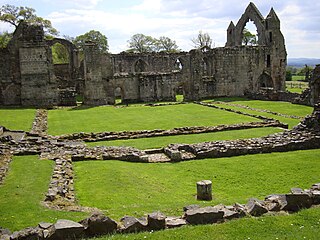
Haughmond Abbey is a ruined, medieval, Augustinian monastery a few miles from Shrewsbury, England. It was probably founded in the early 12th century and was closely associated with the FitzAlan family, who became Earls of Arundel, and some of their wealthier vassals and allies. It was a substantial, successful and wealthy house for most of its four centuries, although evidence of abuses appeared before its dissolution in 1539. The buildings fell into disrepair and the church was largely destroyed, although the remains of some of the domestic buildings remain impressive. The site is now in the care of English Heritage and is open to the public during the summer.
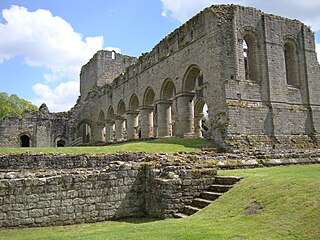
Buildwas Abbey was a Cistercian monastery located on the banks of the River Severn, at Buildwas, Shropshire, England - today about two miles (3 km) west of Ironbridge. Founded by the local bishop in 1135, it was sparsely endowed at the outset but enjoyed several periods of growth and increasing wealth: notably under Abbot Ranulf in the second half of the 12th century and again from the mid-13th century, when large numbers of acquisitions were made from the local landed gentry. Abbots were regularly used as agents by Plantagenet in their attempts to subdue Ireland and Wales and the abbey acquired a daughter house in each country. It was a centre of learning, with a substantial library, and was noted for its discipline until the economic and demographic crises of the 14th century brought about decline and difficulties, exacerbated by conflict and political instability in the Welsh Marches. The abbey was suppressed in 1536 as part of the Dissolution of the Monasteries under Henry VIII. Substantial remains of the abbey church and monk's quarters remain and are in the care of English Heritage.
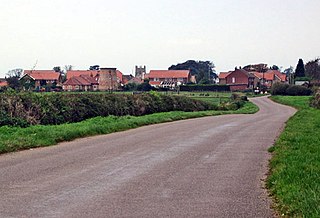
Croxton Kerrial is a village and civil parish in the Melton borough of Leicestershire, England, 6.6 miles (10.6 km) south-west of Grantham, 7.9 miles (12.7 km) north-east of Melton Mowbray, and 0.5 miles (0.8 km) west of Leicestershire's border with Lincolnshire. The civil parish includes the village of Branston and had a population of 530 at the 2011 census.

Halesowen Abbey was a Premonstratensian abbey in Halesowen, England of which only ruins remain. Founded by Peter des Roches with a grant of land from King John, the abbey's official year of inauguration was 1218. It acquired two daughter abbeys and a dependent priory. It also acquired a considerable range of estates, mostly concentrated within the region, and a number of churches, which it appropriated after being granted the advowsons. The abbey's manorial court records have survived in large part, portraying a discontented community, driven to many acts of resistance and at one point to challenge the abbey's very existence. The abbey played no great part in the affairs of its order, although it was represented at all levels. At least one abbot attracted serious criticism from within the order, which attempted to remove him. Its canons observed the Rule of St Augustine to a varying degree, with some serious lapses, at least in the late 15th century, when the order's visitor uncovered widespread sexual exploitation of local women. The abbey was moderately prosperous and survived the suppression of the lesser monasteries. It was dissolved in 1538.

Leiston Abbey outside the town of Leiston, Suffolk, England, was a religious house of Canons Regular following the Premonstratensian rule, dedicated to St Mary. Founded in c. 1183 by Ranulf de Glanville, Chief Justiciar to King Henry II (1180-1189), it was originally built on a marshland isle near the sea, and was called "St Mary de Insula". Around 1363 the abbey suffered so much from flooding that a new site was chosen and it was rebuilt further inland for its patron, Robert de Ufford, 1st Earl of Suffolk (1298-1369). However, there was a great fire in c. 1379 and further rebuilding was necessary.

Aldringham is a village in the Blything Hundred of Suffolk, England. The village is located 1 mile south of Leiston and 3 miles northwest of Aldeburgh close to the North Sea coast. The parish includes the coastal village of Thorpeness. The mid-2005 population estimate for Aldringham cum Thorpe parish was 730.

Kingswood Abbey was a Cistercian abbey, located in the village of Kingswood near Wotton-under-Edge, Gloucestershire, England. The abbey was demolished during the Dissolution of the Monasteries, and all that remains is the gatehouse, a Grade 1 listed building. Through the gatehouse arch are a few houses and the small village primary school of Kingswood.

Burton Abbey at Burton upon Trent in Staffordshire, England, was founded in the 7th or 9th century by St Modwen or Modwenna. It was refounded in 1003 as a Benedictine abbey by the thegn Wulfric Spott. He was known to have been buried in the abbey cloister in 1010, alongside the grave of his wife.

Langdon is a civil parish in the Dover district of Kent, England, and contains the villages of East Langdon and West Langdon, and the hamlets of Martin and Martin Mill. Langdon was the site of Langdon Abbey which was dissolved in 1535.

Pontefract Priory was a Cluniac monastery dedicated to St. John the Evangelist, founded about 1090 by Robert de Lacy, 2nd Baron of Pontefract, and located in Yorkshire, England. It existed until the dissolution of the monasteries. The Church and buildings have been completely destroyed, but the site is still indicated by the name of Monk-hill.

Newsham Abbey was an abbey in Newsham, a small hamlet north of Brocklesby village in Lincolnshire, England. Founded by Peter of Gousla in 1143, Newsham was a daughter house of the Abbey of Licques, near Calais, and the first Premonstratensian house established in England.

Butley Priory, sometimes called Butley Abbey, was a religious house of Canons regular in Butley, Suffolk, dedicated to The Blessed Virgin Mary. It was founded in 1171 by Ranulf de Glanville, Chief Justiciar to King Henry II (1180-1189), and was the sister foundation to Ranulf's house of White canons (Premonstratensians) at Leiston Abbey, a few miles to the north, founded c. 1183. Butley Priory was suppressed in 1538.
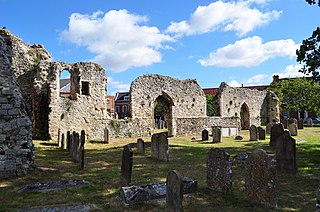
Bungay Priory was a Benedictine nunnery in the town of Bungay in the English county of Suffolk. It was founded c. 1160-1185 by the Countess Gundreda, wife or widow of Hugh Bigod, 1st Earl of Norfolk, upon lands of her maritagium and was confirmed to her and her second husband Roger de Glanville by King Henry II. It was dissolved in about 1536. At the time of the suppression it consisted of a prioress and 11 nuns. The priory church, the Church of the Holy Cross, became the Church of St Mary, the parish church in Bungay. Although ruins of the priory remain to the east of the church, any remaining intact buildings are likely to have been destroyed in the Bungay fire of 1688 which severely damaged the church itself. The church and the ruins of the priory are a Grade I listed building.
William d'Aubigny, sometimes William de Albini, was an Anglo-French baron and administrator who served successive kings of England and acquired large estates in Norfolk. From his title of Butler to King Henry I of England, he was called William d'Aubigny Pincerna to distinguish him from other men of the same name.
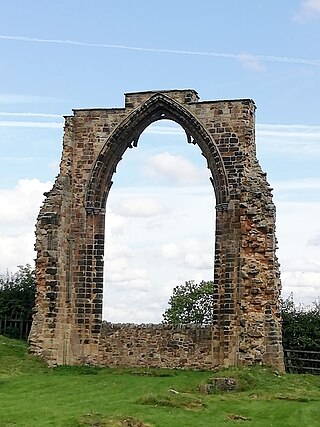
Dale Abbey, also known as the Abbey of Stanley Park, was a religious house, close to Ilkeston in Derbyshire. Its ruins are located at the village of Dale Abbey, which is named after it. Its foundation legend portrays it as developing from a hermitage, probably in the early 12th century. After several false starts, it was finally constituted as an abbey in 1204. It was affiliated to the Premonstratensians, an order of canons regular in which it played, at times, a leading part among English Houses. It acquired a large number of small properties, concentrated in areas of the East Midlands, developed a network of granges and appropriated a number of lucrative parish churches. Its discipline and reputation varied considerably, particularly in the 15th century, and it seems to have fallen away from the originally austerity. By 1536 its income was well below the threshold set for the Dissolution of Lesser Monasteries. Although there were accusations of grave immorality, the abbey was allowed to pay a fine to continue its existence until 1538.


















